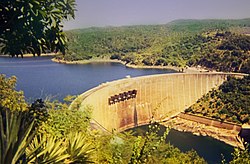Water supply and sanitation in Zimbabwe
Water supply and sanitation in Zimbabwe faces significant challenges, marked by both successful localized efforts and widespread deficiencies in infrastructure.
According to the 2019 Multiple Indicator Cluster Surveys (MICS), conducted by UNICEF, disparities persist in access to clean drinking water and sanitation facilities.
Additionally, approximately 67.8% of households have access to improved, non-shared sanitation facilities, indicating ongoing challenges in this domain.
[2][3] Conditions throughout the 1980s and the early 1990s were highly advantageous to Zimbabwe's water and sanitation sectors due to the massive support from the incoming elected majority government as well as an influx of foreign investment.
[4] Although IRWSSP did not achieve this goal, it was still greatly beneficial as Zimbabwe experienced, according to the African Development Bank, "one of the highest rates of growth in water supply and sanitation services"[5] between the years 1980 to 2000.
[9] Some of Zimbabwe’s commitments through SWA include, but are not limited to, 1) “develop, launch and roll-out a national Strategy to reduce open defecation to 21.7% to 9% by 2025, 2) fully fund the building of efficient regulatory institutions, devolved delivery and coordination capacity by 2022, and 3) achieve 80% access to potable water by 2025.”[9] UNICEF Zimbabwe's Annual Report from 2023 highlighted large scale programs to benefit the most vulnerable women and children in the country, including in regards to clean and safe water.
During El Niño events, Zimbabwe typically experiences below-average rainfall, leading to drought conditions and water scarcity.
[15] Roughly 90% of the rainfall in the country is caused by convective forces, the upward movement of warm air that leads to the formation of clouds and rain.
Subsequently, Lisben Chipfunde, the head of amenities and environment in the Harare City Council, confirmed that the water shortage persisted, exacerbating the situation, particularly during the 2019-2020 rainy season.
This dire situation forced residents to resort to using unsafe and contaminated water sources, such as wells and boreholes, further jeopardizing public health and exacerbating the risk of waterborne diseases like cholera.
[2] These entities work with the WASH coalition, including NGOs, UNICEF, and private groups chaired by the Ministry of Health and Child Welfare, to finance and build water supply and sanitation systems in line with the UN Millennium Development Goal.
The combination of limited systems, a growing population, and many people’s inability to afford access to water, has resulted in extreme corruption and inequity.
The water and sanitation crisis in Harare, Zimbabwe, poses severe health risks, as highlighted in a 2013 report by Human Rights Watch.
The report reveals challenges like limited access to clean water and sanitation services, leading residents to drink from contaminated sources and practice open defecation.
Government failure to maintain the system forces reliance on unsafe sources, violating residents' right to clean water.
[26] A number of foreign governments and NGOs are actively working to improve water supply and sanitation in Zimbabwe through both small and large scale infrastructure projects.
Through its WASH program, UNICEF is dedicated to ensuring universal access to clean water, sanitation, and hygiene facilities across communities worldwide.
Collaboratively, UNICEF and the WASH program strive to extend access to safe water and sanitation to 2.3 million people in Zimbabwe currently lacking these essential services.
"[28] UNICEF reached hundreds of thousands of people with "climate resilient, basic, safe water through risk-informed planning, multi-use systems and capacity building for sustainability.
[27][29] In particular the water of several rivers that go through the Marange diamond fields in eastern Zimbabwe has been so polluted that it has killed livestock that drank it and given rashes to bathers.
This is due to the large population of Harare, decrepit and broken sewage systems, and mismanagement by government agencies designated to enforce environmental and water quality regulations.
Improved water supply and sanitation sectors are shown to be highly effective at reducing the rates of morbidity and mortality for many illnesses including ascariasis, cholera, diarrhea, dracunculiasis, hookworm infection, schistosomiasis, and trachoma.
The 2008 outbreak of Cholera was especially concerning due to the spiraling political and economic crisis, which led to a collapse of many public services and an inconsistency in fresh water supplies.
[34] The 2018 outbreak was smaller, and curtailed, due to the fortunate preparation and administration of the oral cholera vaccine (OCV), of which 2.5 million doses were provided, especially in high-risk populations.
Malawi, being the worst affected, received three shipments of OCV "in response to applications to the Gavi-supported global oral cholera vaccine stockpile, established in 2013.
"[34] Water supply and sanitation in Zimbabwe faces significant challenges, with both successful localized efforts and widespread deficiencies in infrastructure.
[35] To address these challenges, UNICEF, in collaboration with the Government of Zimbabwe and funded by the UK's Department for International Development, is implementing a Rural WASH Programme.
This policy utilizes demand-led Sanitation Focused Participatory Health and Hygiene Education (SafPHHE), implemented in the 45 supported rural districts.

